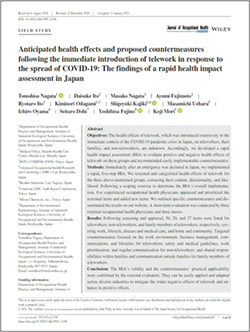#0112 Anticipated health effects and proposed countermeasures following the immediate introduction of telework in response to the spread of COVID-19: The findings of a rapid health impact assessment in Japan

A Health Impact Assessment Provides Insights Into the Health Effects of Telework and Appropriate Countermeasures for Adverse Effects
The ongoing COVID-19 pandemic has led many technologically advanced countries to encourage workers to use telecommunications to become teleworkers. While the widespread adoption of telework is an effective way of reducing direct interpersonal contact and the associated opportunities for virus transmission, its health effects for teleworkers, their families, and non-teleworkers are largely unknown.
To facilitate research into the health effects of telework for the aforementioned groups, we worked to develop a rapid health impact assessment tool relevant to telework. As described in an article recently published in the Journal of Occupational Health, we implemented a rapid, five-step health impact assessment immediately after the Japanese government declared an emergency, and we screened and categorized the health effects of telework on teleworkers, their family members, and non-teleworkers. After several steps to develop an easily implementable screening tool, five experienced occupational health physicians appraised the various items, prioritized them, and added some new items.
After appraisal and prioritization, the finalized health impact assessment tool included 59 items for teleworkers, 29 items for non-teleworkers, and 27 items for the family members of teleworkers. These items covered work factors, lifestyle factors, factors related to disease and medical care, and factors related to home and community.
Next, we proceeded to outline some countermeasures for the potential adverse health effects specific to each group. For teleworkers, the proposed countermeasures focused on the work environment, business management, communications, and lifestyles. For non-teleworkers, the proposed countermeasures focused on safety and medical guidelines, work prioritization, and regular communication. For the family members of teleworkers, the proposed countermeasures focused on shared responsibilities within families and communication outside families.
An external team of three occupational health physicians and three nurses subsequently conducted a short-term evaluation of the health impact assessment and the proposed countermeasures for adverse health effects, and the evaluators agreed that the assessment was valid and that the proposed countermeasures were practical. They can be applied and adapted across diverse industries, and will therefore prove valuable to occupational health professionals who are working to mitigate the negative health effects that telework can have.

Link to the original journal article:
https://onlinelibrary.wiley.com/doi/10.1002/1348-9585.12198
Title of the paper:
Anticipated health effects and proposed countermeasures following the immediate introduction of telework in response to the spread of COVID-19: The findings of a rapid health impact assessment in Japan
Authors:
Tomohisa Nagata, Daisuke Ito, Masako Nagata, Ayumi Fujimoto, Ryotaro Ito, Kiminori Odagami, Shigeyuki Kajiki, Masamichi Uehara, Ichiro Oyama, Seitaro Dohi, Yoshihisa Fujino, and Koji Mori




